Influence of Lower Lateral Bracing on the Seismic Pounding Damage to Slab-On-Girder Steel Bridges
Abstract
:1. Introduction
2. Bridge Model and Ground Motion
2.1. Bridge Model
2.2. Element and Material Properties
2.3. Contact and Boundary Conditions
2.4. Ground Motions
3. Numerical Results
3.1. Validation of the Model
3.2. Response under Transverse Seismic Actions
3.3. Response under Horizontal Bidirectional Seismic Actions
3.4. Failure of the Lower Lateral Bracing
4. Discussion
5. Conclusions
- Under transverse seismic actions, the steel beams on both sides will experience seismic pounding and be damaged. For steel bridges with lower lateral bracing, the lateral collision damage of the steel beam is significantly reduced due to the sharing and transmission of the pounding force by the lower lateral bracing. The lower lateral bracing can share about 1/3 of the pounding action and reduce the displacement angle of the steel beam by 40%.
- Under horizontal two-way seismic actions, the seismic response and damage of the steel beams on both sides are significantly amplified. Although the lower lateral bracing only slightly reduces the stress at the key, it significantly reduces the stress on other parts of the steel beam. The lower lateral bracing only elastically bends vertically under the full action of the earthquake.
- The lower lateral bracing connection with discontinuous vertical stiffness will bend and deform in the area of sudden stiffness; that is, connection failure will occur. After the connection fails, the lower lateral bracing will lose the lateral support effect on the steel beam.
Author Contributions
Funding
Institutional Review Board Statement
Informed Consent Statement
Data Availability Statement
Conflicts of Interest
References
- Kharazian, A.; López-Almansa, F. State-of-the-Art of Research on Seismic Pounding between Buildings with Aligned Slabs. Arch. Comput. Methods Eng. 2017, 26, 327–345. [Google Scholar] [CrossRef]
- Miari, M.; Choong, K.K.; Jankowski, R. Seismic Pounding between Bridge Segments: A State-of-the-Art Review. Arch. Comput. Methods Eng. 2020, 28, 495–504. [Google Scholar] [CrossRef]
- Association, J.B. Kumamoto Earthquake Bridge Damage Survey Report; Asian Disaster Reduction Center (ADRC): Kobe, Japan, 2016. [Google Scholar]
- Bi, K.M.; Hao, H.; Chouw, N. Influence of ground motion spatial variation, site condition and SSI on the required separation distances of bridge structures to avoid seismic pounding. Earthq. Eng. Struct. Dyn. 2011, 40, 1027–1043. [Google Scholar] [CrossRef]
- Jankowski, R. Pounding between Superstructure Segments in Multi-Supported Elevated Bridge with Three-Span Continuous Deck Under 3D Non-Uniform Earthquake Excitation. J. Earthq. Tsunami 2015, 9, 1550012. [Google Scholar] [CrossRef]
- Li, N.N.; Xu, W.B.; Chen, Y.J.; Yan, W.M. Experimental research on adjacent pounding effect of midspan curved bridge with longitudinal slope. Eng. Struct. 2019, 196, 109320. [Google Scholar] [CrossRef]
- Bi, K.M.; Hao, H. Modelling of shear keys in bridge structures under seismic loads. Soil Dyn. Earthq. Eng. 2015, 74, 56–68. [Google Scholar] [CrossRef]
- Yang, M.G.; Meng, D.L.; Gao, Q.; Zhu, Y.P.; Hu, S.T. Experimental study on transverse pounding reduction of a high-speed railway simply-supported girder bridge using rubber bumpers subjected to earthquake excitations. Eng. Struct. 2019, 196, 109290. [Google Scholar] [CrossRef]
- Xu, L.Q.; Fu, P.Y.; Spencer, B.F. Maintaining bridge alignment during seismic events: Shear key design and implementation guidelines. J. Bridge Eng. 2020, 25, 04020017. [Google Scholar] [CrossRef]
- Meng, D.; Yang, M.; Yang, Z.; Chouw, N. Effect of earthquake-induced transverse poundings on a 32 m span railway bridge isolated by friction pendulum bearings. Eng. Struct. 2022, 251, 113538. [Google Scholar] [CrossRef]
- Jankowski, R.; Wilde, K.; Fujino, Y. Reduction of pounding effects in elevated bridges during earthquakes. Earthq. Eng. Struct. Dyn. 2000, 29, 195–212. [Google Scholar] [CrossRef]
- Guo, A.X.; Li, Z.J.; Li, H.; Ou, J.P. Experimental and analytical study on pounding reduction of base-isolated highway bridges using MR dampers. Earthq. Eng. Struct. Dyn. 2009, 38, 1307–1333. [Google Scholar] [CrossRef]
- Shrestha, B.; Hao, H.; Ibrahim, N.H.J.; Bi, K.M. On the effectiveness of rotational friction hinge damper to control responses of multi-span simply supported bridge to non-uniform ground motions. Adv. Struct. Eng. 2016, 19, 1575–1591. [Google Scholar] [CrossRef]
- Won, J.H.; Mha, H.S.; Kim, S.H. Effects of the earthquake-induced pounding upon pier motions in the multi-span simply supported steel girder bridge. Eng. Struct. 2015, 93, 1–12. [Google Scholar] [CrossRef]
- Zheng, Y.; Xiao, X.; Zhi, L.H.; Wang, G.B. Evaluation on impact interaction between abutment and steel girder subjected to nonuniform seismic excitation. Shock Vib. 2015, 2015, 981804. [Google Scholar] [CrossRef]
- Aye, M.N.; Kasai, A.; Shigeishi, M. An investigation of damage mechanism induced by earthquake in a plate girder bridge based on seismic response analysis: Case study of Tawarayama bridge under the 2016 Kumamoto earthquake. Adv. Civ. Eng. 2018, 2018, 9293623. [Google Scholar]
- Mustafa, S.; Miki, C. Design of rupture strength of side blocks in elevated steel girder bridges with elastomeric bearings. Int. J. Steel Struct. 2020, 20, 885–896. [Google Scholar] [CrossRef]
- Dassault, S. Abaqus 2016 Analysis User’s Guide; Dassault Systèmes: Paris, France, 2016. [Google Scholar]
- Tang, Z.Z.; Xie, X.; Wang, T.; Wang, J.Z. Study on FE models in elasto-plastic seismic performance evaluation of steel arch bridge. J. Constr. Steel Res. 2015, 113, 209–220. [Google Scholar] [CrossRef]
- Chaboche, J.L. A review of some plasticity and viscoplasticity constitutive theories. Int. J. Plast. 2008, 24, 1642–1693. [Google Scholar] [CrossRef]
- Shi, Y.J.; Wang, M.; Wang, Y.Q. Experimental study of structural steel constitutive relationship under cyclic loading. J. Build. Mater. 2012, 15, 293–300. (In Chinese) [Google Scholar]
- Xing, Y.; Xu, Y.N.; Guo, Q.; Jiao, J.F.; Chen, Q.W. Experimental study on friction performance of damaged interface in steel-concrete composite beam connected by high-strength bolt. Adv. Struct. Eng. 2021, 24, 334–345. [Google Scholar] [CrossRef]
- Baker, J.W. Quantitative classification of near-fault ground motions using wavelet analysis. Bull. Seismol. Soc. Am. 2007, 97, 1486–1501. [Google Scholar] [CrossRef]
- Ahmadi, M.; Nikkhoo, A. Utilization of characteristic polynomials in vibration analysis of non-uniform beams under a moving mass excitation. Appl. Math. Model. 2014, 38, 2130–2140. [Google Scholar] [CrossRef]
- Lei, T.; Zheng, Y.F.; Yu, R.J.; Yan, Y.K.; Xu, B. Dynamic Response of Slope Inertia-Based Timoshenko Beam under a Moving Load. Appl. Sci. 2022, 12, 3045. [Google Scholar] [CrossRef]
- Ouzizi, A.; Abdoun, F.; Azrar, L. Nonlinear dynamics of beams on nonlinear fractional viscoelastic foundation subjected to moving load with variable speed. J. Sound Vib. 2022, 523, 116730. [Google Scholar] [CrossRef]
- Shi, F.; Wang, D.S.; Cheng, L. Study of flexural vibration of variable cross-section box-girder bridges with corrugated steel webs. Structures 2021, 33, 1107–1118. [Google Scholar] [CrossRef]
- Tang, W.J.; Wang, D.S.; Huang, H.B.; Dai, J.C.; Shi, F. A pre-trained deep learning model for fast online prediction of structural seismic responses. Int. J. Struct. Stab. Dyn. 2023. [Google Scholar] [CrossRef]
- Hsiao, I.H.; Chung, C.Y. AI-infused semantic model to enrich and expand programming question generation. J. Artif. Intell. Technol. 2022, 2, 47–54. [Google Scholar] [CrossRef]
- Du, H.; Du, S.; Li, W. Probabilistic time series forecasting with deep non-linear state space models. CAAI Trans. Intell. Technol. 2023, 8, 3–13. [Google Scholar] [CrossRef]

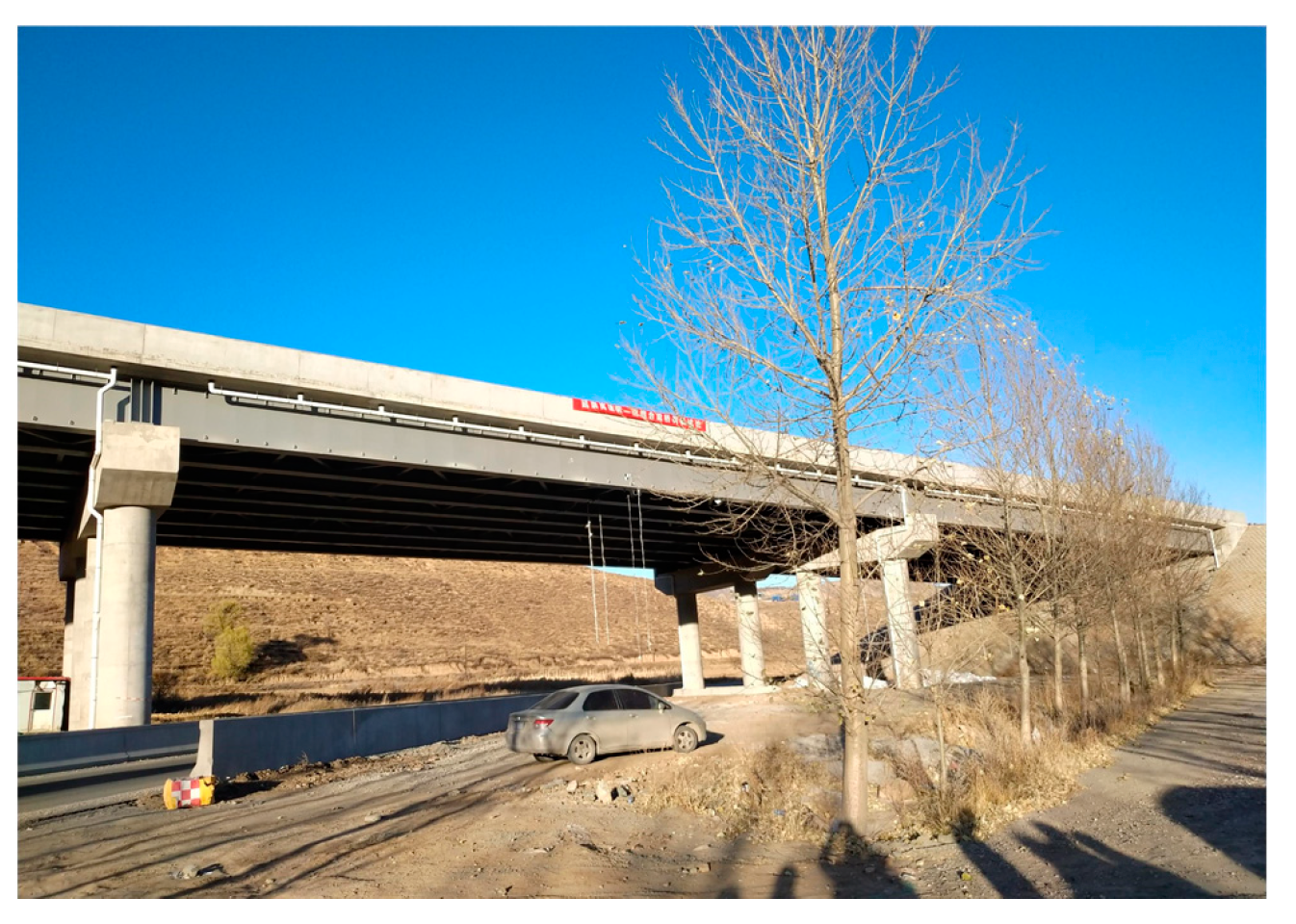
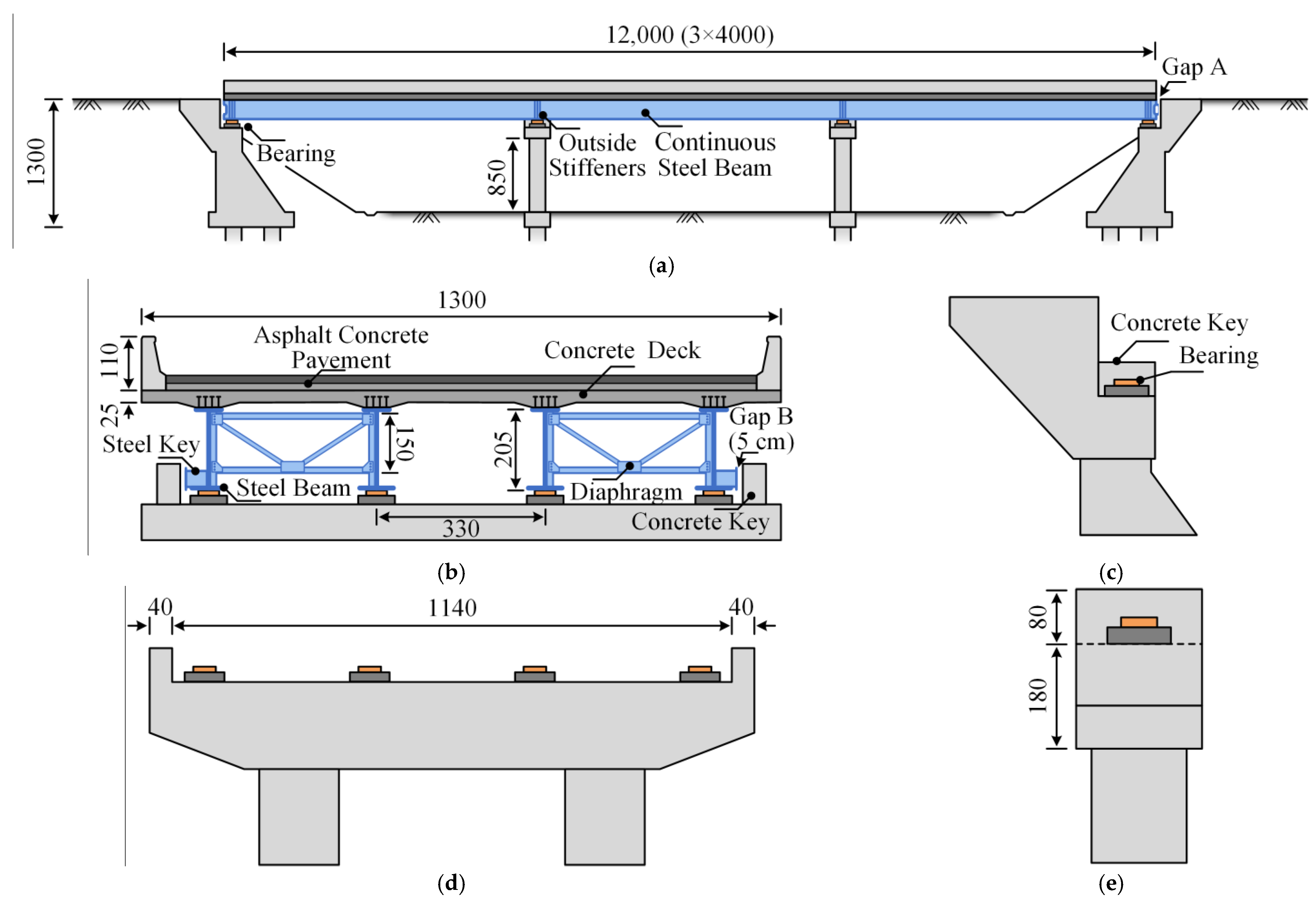
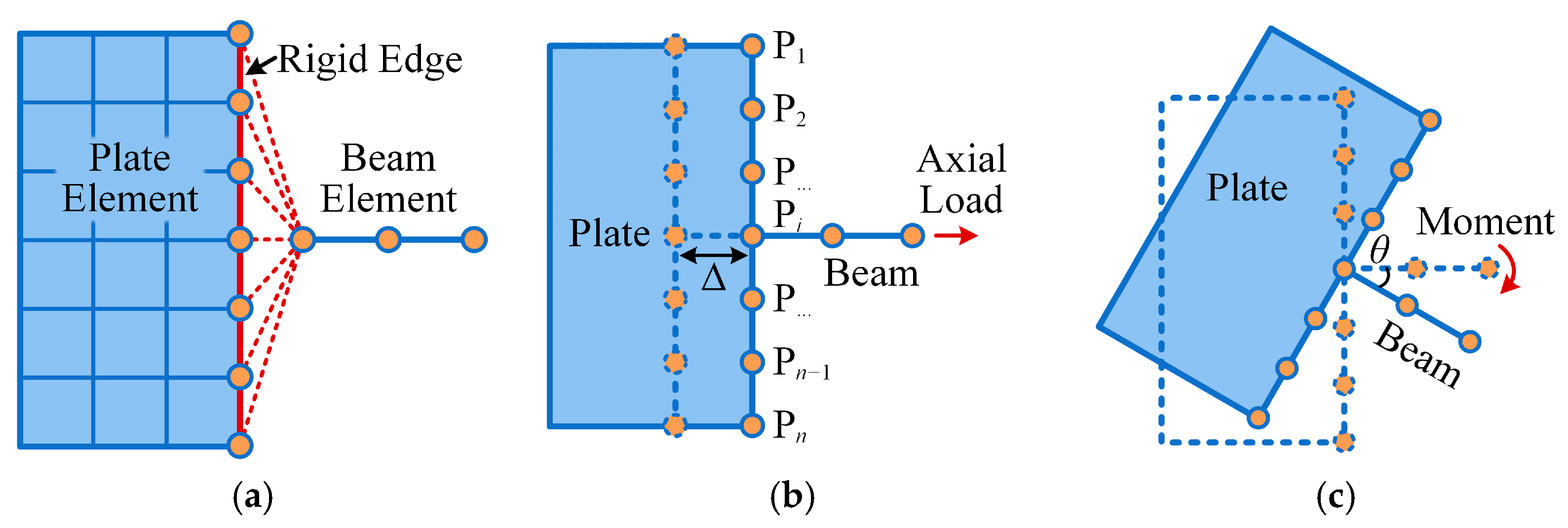
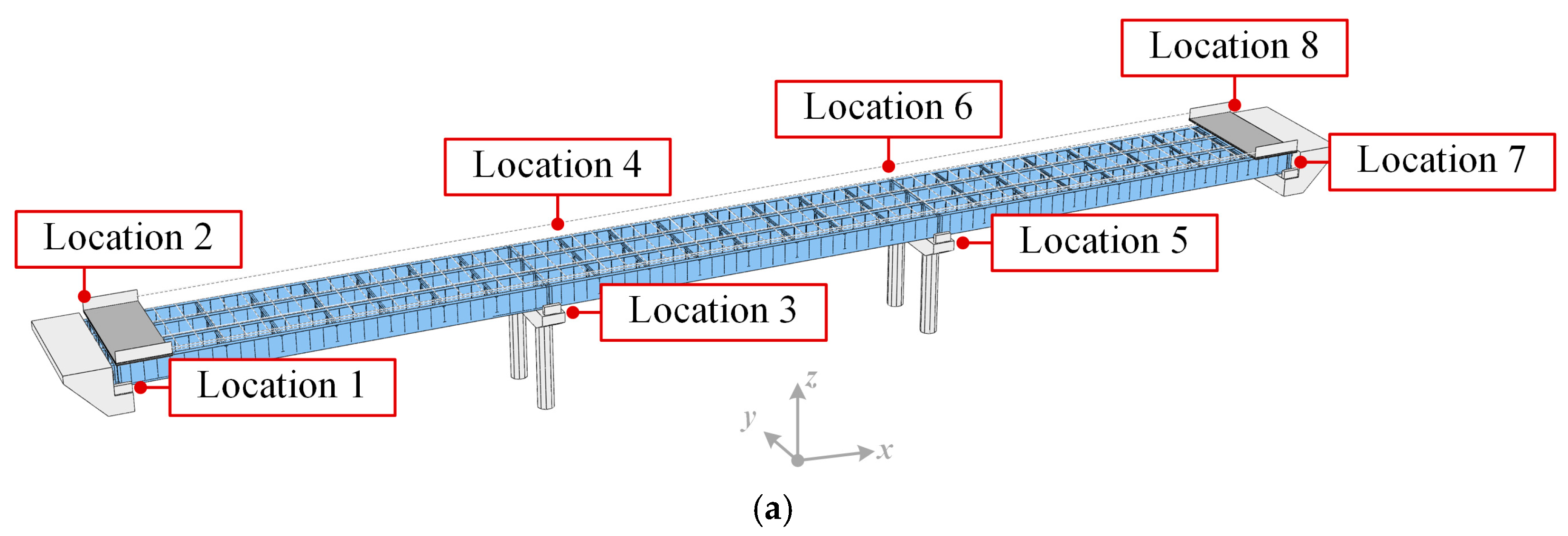
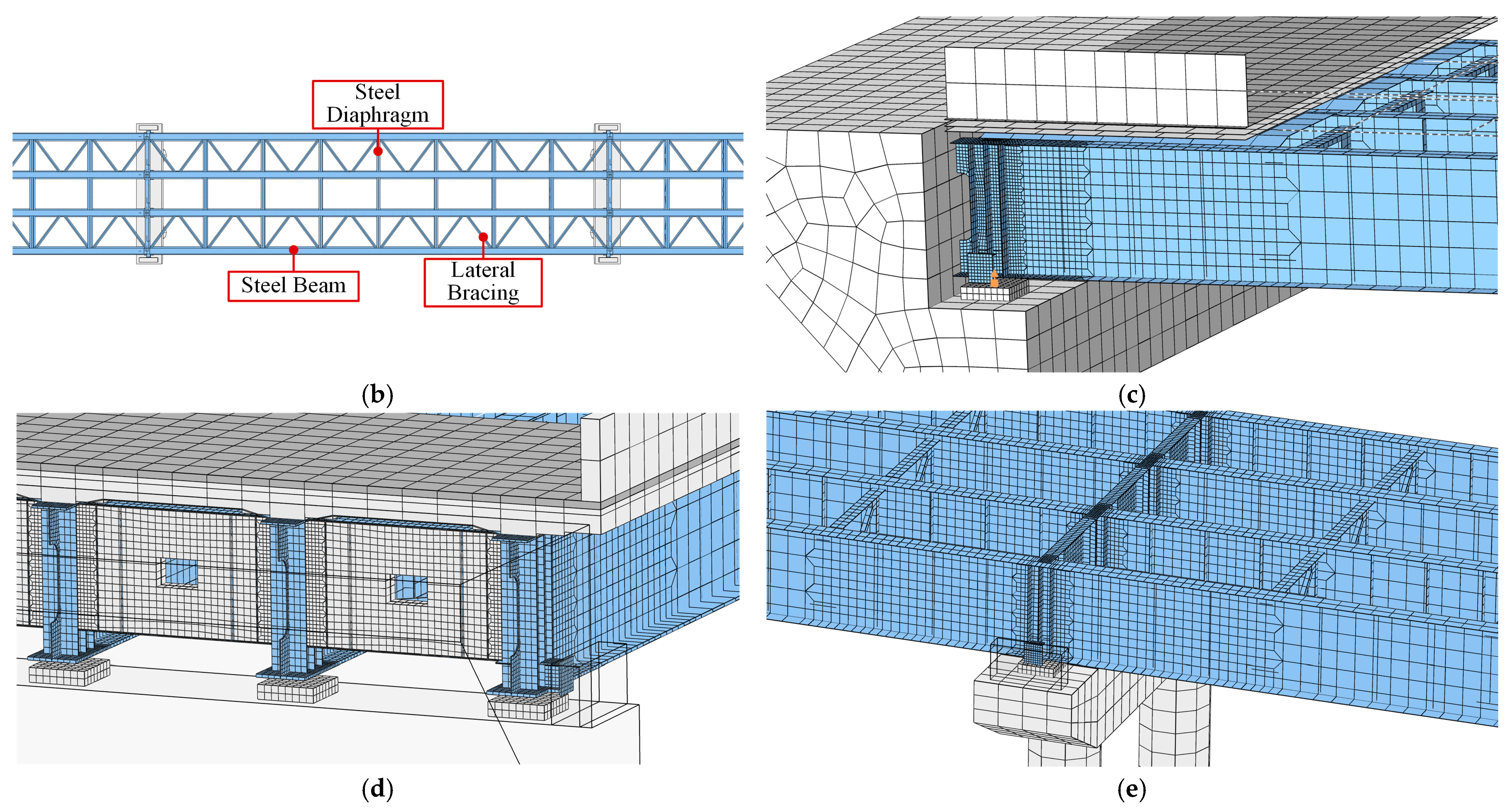
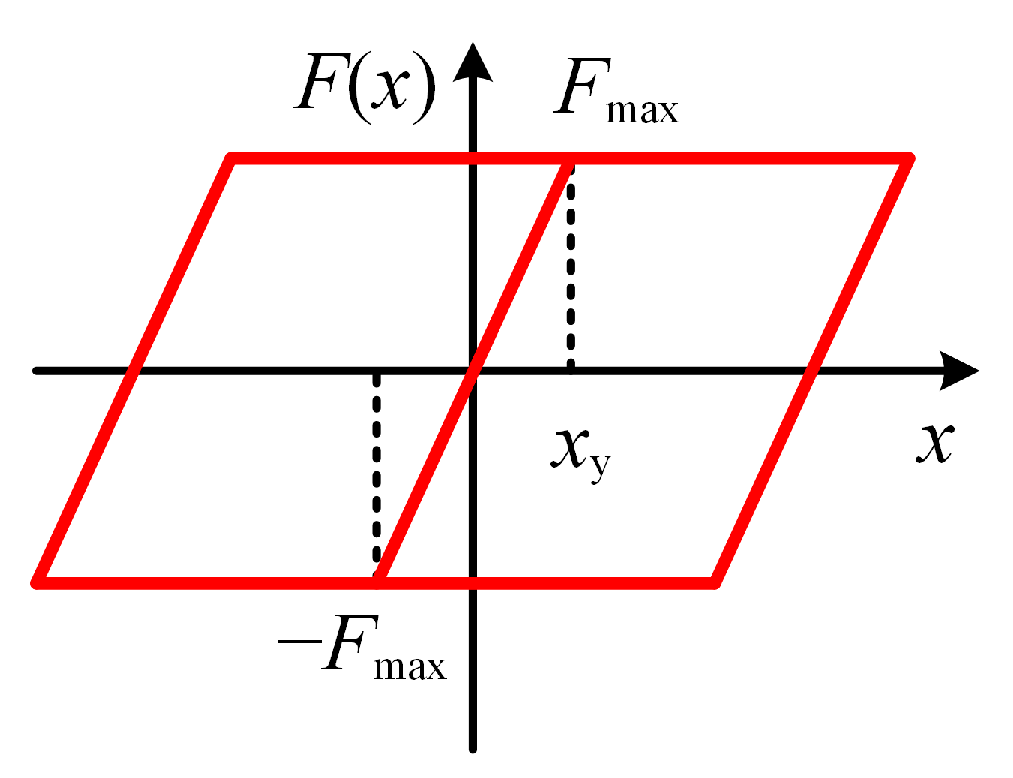



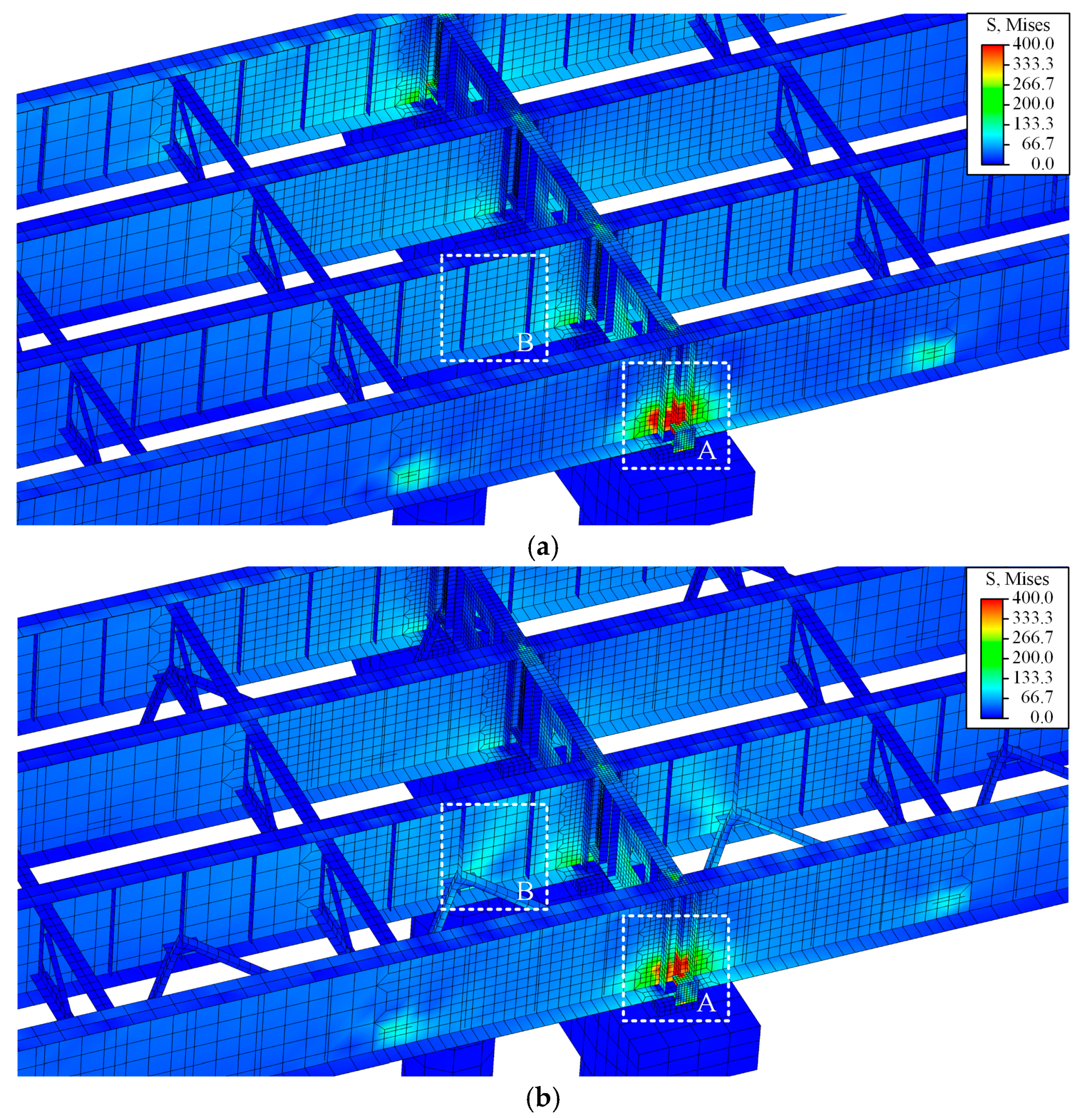

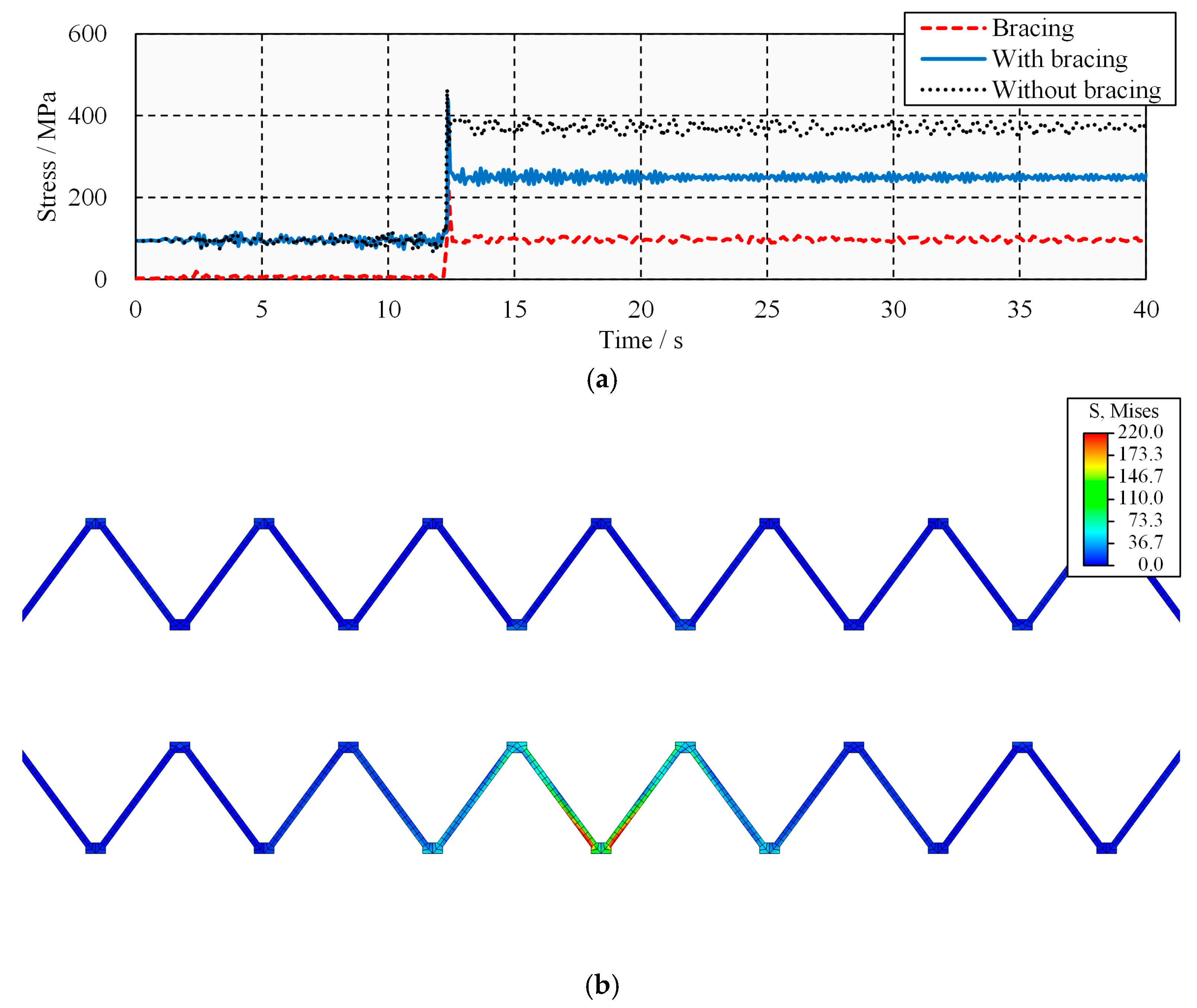
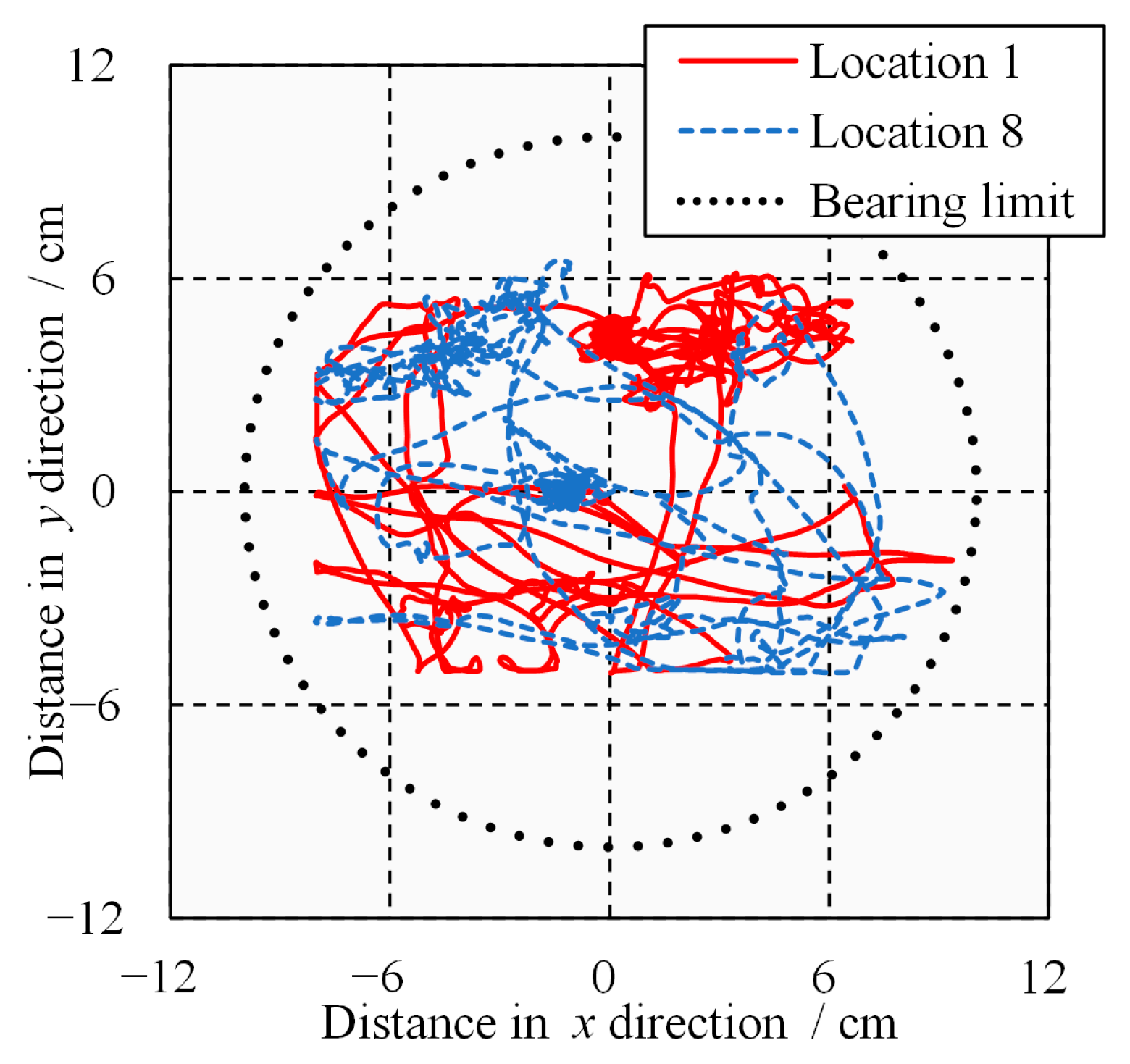

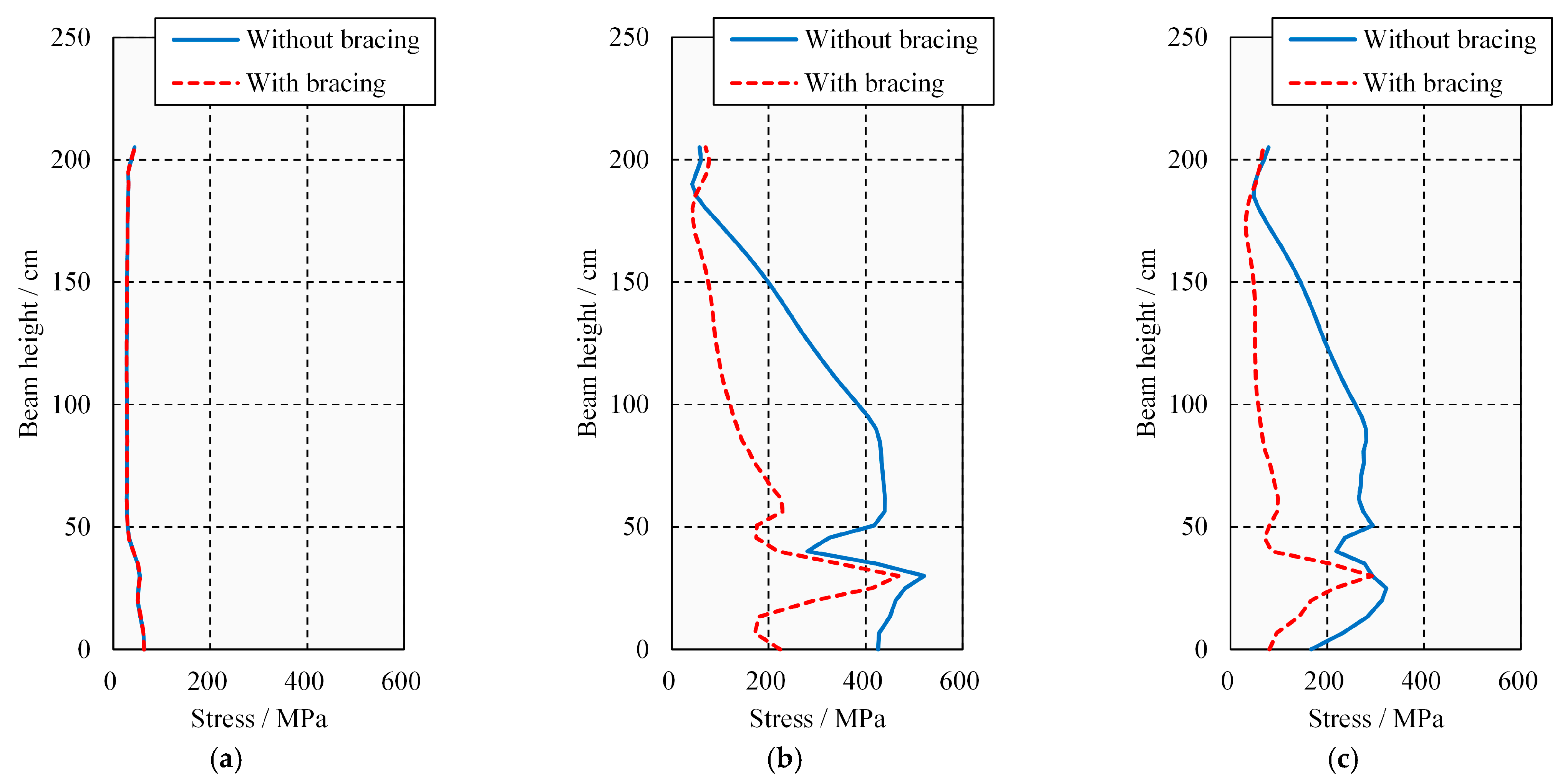


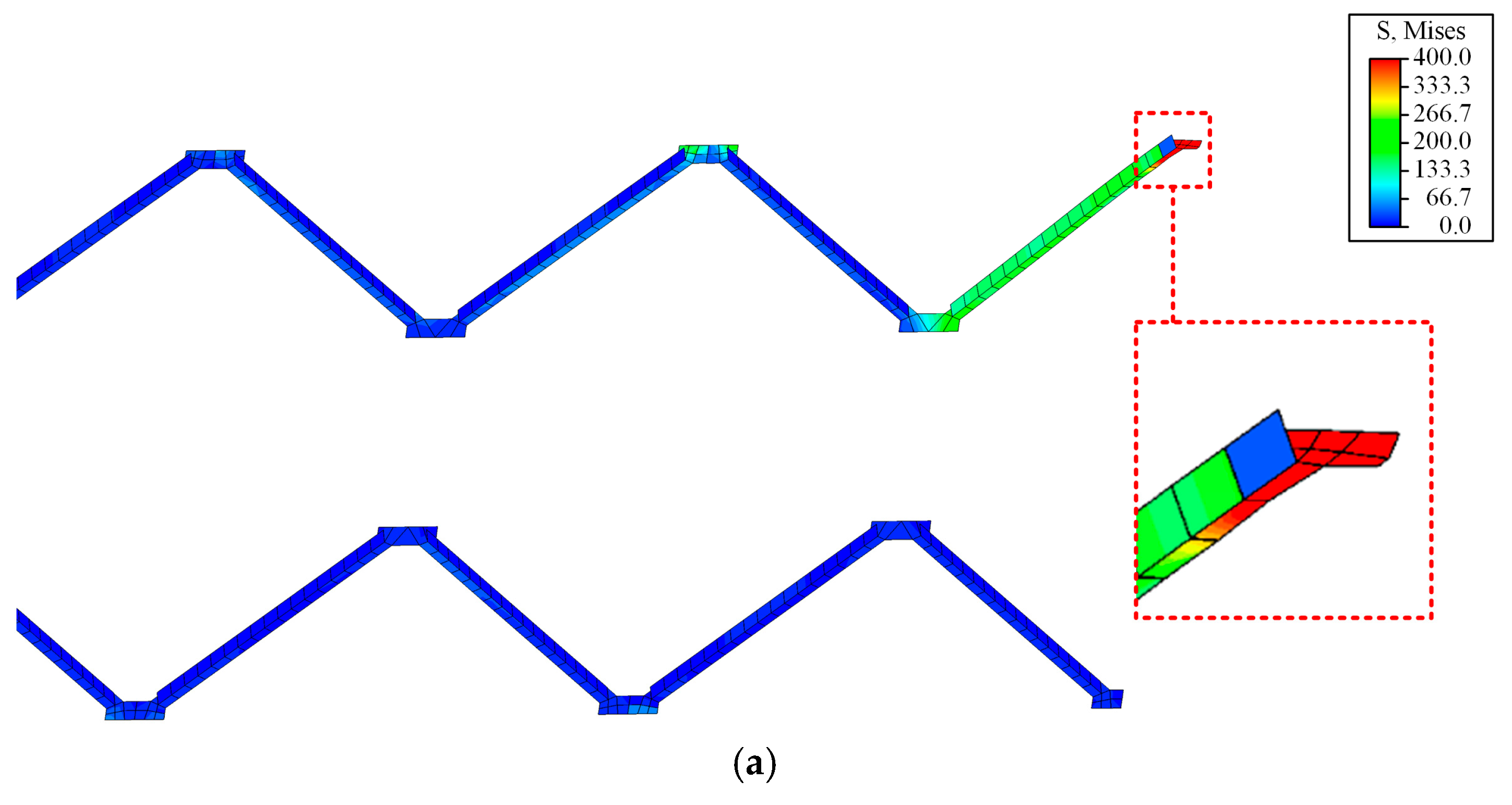


| σ|0/MPa | Q∞/MPa | biso | C1/MPa | γ1 | C2/MPa | γ2 | C3/MPa | γ3 | C4/MPa | γ4 |
|---|---|---|---|---|---|---|---|---|---|---|
| 429 | 21 | 1.2 | 7993 | 175 | 6773 | 116 | 2854 | 34 | 1450 | 29 |
| NO. | Frequency/Hz | Error/% | Mode Shape Description | |
|---|---|---|---|---|
| Test | FEM | |||
| 1 | 2.91 | 2.80 | 3.81 | Vertical antisymmetric bending |
| 2 | 3.66 | 3.46 | 2.51 | Vertical bending on side spans |
| 3 | 4.76 | 4.64 | 5.43 | Vertical symmetrical bending |
Disclaimer/Publisher’s Note: The statements, opinions and data contained in all publications are solely those of the individual author(s) and contributor(s) and not of MDPI and/or the editor(s). MDPI and/or the editor(s) disclaim responsibility for any injury to people or property resulting from any ideas, methods, instructions or products referred to in the content. |
© 2023 by the authors. Licensee MDPI, Basel, Switzerland. This article is an open access article distributed under the terms and conditions of the Creative Commons Attribution (CC BY) license (https://creativecommons.org/licenses/by/4.0/).
Share and Cite
Shi, F.; Wang, D.; Tong, L.; Dai, J. Influence of Lower Lateral Bracing on the Seismic Pounding Damage to Slab-On-Girder Steel Bridges. Appl. Sci. 2023, 13, 12787. https://doi.org/10.3390/app132312787
Shi F, Wang D, Tong L, Dai J. Influence of Lower Lateral Bracing on the Seismic Pounding Damage to Slab-On-Girder Steel Bridges. Applied Sciences. 2023; 13(23):12787. https://doi.org/10.3390/app132312787
Chicago/Turabian StyleShi, Fan, Dongsheng Wang, Lei Tong, and Jiancheng Dai. 2023. "Influence of Lower Lateral Bracing on the Seismic Pounding Damage to Slab-On-Girder Steel Bridges" Applied Sciences 13, no. 23: 12787. https://doi.org/10.3390/app132312787
APA StyleShi, F., Wang, D., Tong, L., & Dai, J. (2023). Influence of Lower Lateral Bracing on the Seismic Pounding Damage to Slab-On-Girder Steel Bridges. Applied Sciences, 13(23), 12787. https://doi.org/10.3390/app132312787







